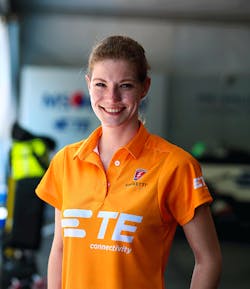>> Electronic Design Resources
.. >> Library: Article Series
.. .. >> Series: Addressing the Gender Gap in Engineering
Judith Henzel, TE Connectivity’s resident engineer working inside the Andretti Autosport shop, is one of only a few female engineers working in Formula E. Since January, she has provided advanced engineering expertise to the MS Amlin Andretti team, helping them boost the performance of its Formula E race car. Electronic Design’s Maria Guerra recently had a chance to talk with Judith about Formula E and women in STEM.
You have a unique job! How did you get into automotive engineering?
After I graduated from high school, I went to England to work as an au pair. When I came back home to Germany, I needed to decide what I wanted to do as a career. I began an internship at a big German airline working in maintenance, and that helped me realize that I wanted to study mechanical engineering.
While pursing my degree, I joined the Formula student racing team at my university. Over the next four years as a team member, I got more passionate and addicted to racing. After graduating from university with a degree in engineering, I got a job at TE Connectivity. TE was very attractive to me because it is one of the few companies that provide recent graduates the chance to start in project management, which is something I was very interested in.
I was working in our automotive business, overseeing global technical infotainment projects for OEMs, when I decided to apply for this rotation program within TE, and got the chance to be the fourth embedded engineer for Andretti Technologies.
Judith Henzel, TE Connectivity resident engineer at Andretti Autosport.
What do you like the most about your current job?
This job is dynamic, even more then the automotive business unit. I am passionate about racing and love being part of a team. The atmosphere at the races is so exciting; you never know exactly what will happen next.
I like that I get to be both innovative and strategic in this role. Also, within the Andretti shop and throughout the racing community, you see a lot of different cultures come together. I love the opportunity to work with various people from all over the world.
I understand you are also an advocate for women in STEM. What would be your advice for women pursuing STEM careers?
In Germany, I was a mentor for a female student in a STEM mentorship program, which is something I really enjoyed. My advice for women or young girls who want to study STEM is to do it with passion. Just be yourself, be self-confident that you are as good in STEM as men. I truly feel that women do have different views and opinions, and are an asset in male-dominated fields.
For me, Formula E is a test-bed for innovations in electric-vehicle (EV) technology. Will any test-bed technology be used on road cars anytime soon?
Every OEM is using Formula E as a platform for new development, and will possibly use this platform for their serial and internal development, and in the end, for serial production. I am sure some of the battery technology will be used within the next three years in serial cars as well.
What is the importance of connectors and sensors for EV racing cars?
Sensors and connectors are important for every type of car, whether it is combustion or a whole electric car. For electric cars, it is possibly even more important. With the sensors, you can collect a lot of data and evaluate it into the smallest detail later. Then you can say exactly what is influencing, for example, the suspension of the car. Without the electric system, the cars would not work at all. So, the electric system, which consists of wiring, connectors, and sensors, is essential.
What are the major challenges for EV racing cars during Season 3?
In Season 3, the powertrain systems were opened for development. That meant teams could design their own motor, inverter, rear suspension, dampers, and so on.
The FIA World Motor Sports Council just confirmed a 10-kW power hike for Season 4, from 170 kW to 180 kW. How do you think this will affect Season 4?
I think this will affect the lap times of the cars; they will go even faster than they do now. It will also present a new challenge for energy management, as more power, even when it is only 10 kW more, is available.
Can you share with us one of the many fulfilling experiences you have had so far traveling around the world with TE and Andretti Team?
It’s all been very exciting, working with the team and getting to travel the world for races. One of the most fulfilling moments for me personally occurred when there was a crash and the car came back into the pits completely ruined and half-destroyed. The whole team (all different kinds of people in various roles) immediately came together and began working to fix the car again and get it back on the track. It was really incredible to see the teamwork in that moment
How do you envision the future of electric vehicles?
I believe electric vehicles are the future of transportation, especially in cities. It’s one reason why I’m so excited I’ve had this opportunity to work with Andretti Technologies and Formula E. This series aims to represent a vision for the future, serving as a framework for R&D around the electric vehicle, accelerating people’s interest in these cars and promoting clean-energy and sustainability.
>> Electronic Design Resources
.. >> Library: Article Series
.. .. >> Series: Addressing the Gender Gap in Engineering


